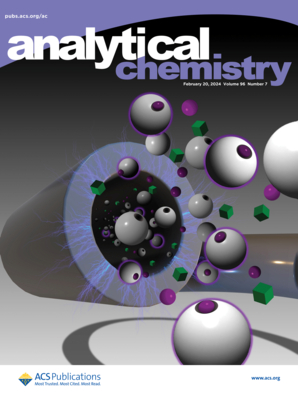Hydrovoltaic–Photoelectric Coupling Strategy Triggered a Robust Output Signal for High-Performance Self-Powered Electrochemical Sensing
IF 6.7
1区 化学
Q1 CHEMISTRY, ANALYTICAL
引用次数: 0
Abstract
Hydrovoltaic self-powered electrochemical sensors hold significant potential for constructing wearable, portable, and real-time detection devices, but the low output signal due to the slow phase transition rate of water molecules and the intricate nature of integration limits their applications. In this work, a hydrovoltaic–photovoltaic coupling effect-enhanced self-powered electrochemical sensor was prepared by combining zinc oxide (ZnO) nanowire arrays with cerium-organometallic framework (Ce-MOF) materials, which greatly improved the electrical output of self-powered electrochemical systems and provided a new detection strategy for an efficient self-powered electrochemical sensing system. The heterojunction constructed by ZnO arrays and Ce-MOF could generate a built-in electric field under the action of light irradiation and promote the separation of the photocarriers. Moreover, the number of charged particles in the film further boosted the water evaporation effect. Notably, the optimal ZnO/Ce-MOF-based self-powered electrochemical device by hydrovoltaic–photoelectric coupling strategy displayed an outstanding output signal, which was 11-fold that of a pure hydrovoltaic-based device. As a proof of concept, the self-powered electrochemical sensing platform was explored for sensitive detection of lincomycin via electrostatic adsorption for the binding of an aptamer. The self-powered sensor showed superior performances, including a wide linear range from 1 fM to 1 nM with a detection limit of 0.2 fM, good stability, and satisfactory recoveries for the determination of lincomycin in real samples, holding great promise in environmental monitoring and food analysis. This study provides a promising avenue to boost the energy conversion efficiency with a high output signal for constructing sensitive self-powered biosensors.

水伏特-光电耦合策略触发了高性能自供电电化学传感的稳健输出信号
水伏特自供电电化学传感器在构建可穿戴、便携和实时检测设备方面具有巨大潜力,但由于水分子相变速度慢,输出信号低,且集成复杂,限制了其应用。在这项工作中,通过将氧化锌(ZnO)纳米线阵列与铈-有机金属框架(Ce-MOF)材料相结合,制备了一种水伏特-光电耦合效应增强型自供电电化学传感器,大大提高了自供电电化学系统的电输出,为高效自供电电化学传感系统提供了一种新的检测策略。氧化锌阵列和 Ce-MOF 构建的异质结在光照作用下可产生内置电场,促进光载体的分离。此外,薄膜中带电粒子的数量进一步提高了水蒸发效果。值得注意的是,基于 ZnO/Ce-MOF 的最佳自供电电化学装置采用了水伏特-光电耦合策略,其输出信号非常出色,是纯水伏特装置的 11 倍。作为概念验证,该自供电电化学传感平台通过静电吸附结合适配体,用于灵敏检测林可霉素。自供电传感器表现出卓越的性能,包括 1 fM 至 1 nM 的宽线性范围(检测限为 0.2 fM)、良好的稳定性和令人满意的回收率,可用于测定实际样品中的林可霉素,在环境监测和食品分析中大有可为。这项研究为构建灵敏的自供电生物传感器提供了一个提高能量转换效率和高输出信号的可行途径。
本文章由计算机程序翻译,如有差异,请以英文原文为准。
求助全文
约1分钟内获得全文
求助全文
来源期刊

Analytical Chemistry
化学-分析化学
CiteScore
12.10
自引率
12.20%
发文量
1949
审稿时长
1.4 months
期刊介绍:
Analytical Chemistry, a peer-reviewed research journal, focuses on disseminating new and original knowledge across all branches of analytical chemistry. Fundamental articles may explore general principles of chemical measurement science and need not directly address existing or potential analytical methodology. They can be entirely theoretical or report experimental results. Contributions may cover various phases of analytical operations, including sampling, bioanalysis, electrochemistry, mass spectrometry, microscale and nanoscale systems, environmental analysis, separations, spectroscopy, chemical reactions and selectivity, instrumentation, imaging, surface analysis, and data processing. Papers discussing known analytical methods should present a significant, original application of the method, a notable improvement, or results on an important analyte.
 求助内容:
求助内容: 应助结果提醒方式:
应助结果提醒方式:


